Singapore Logistics Market Size
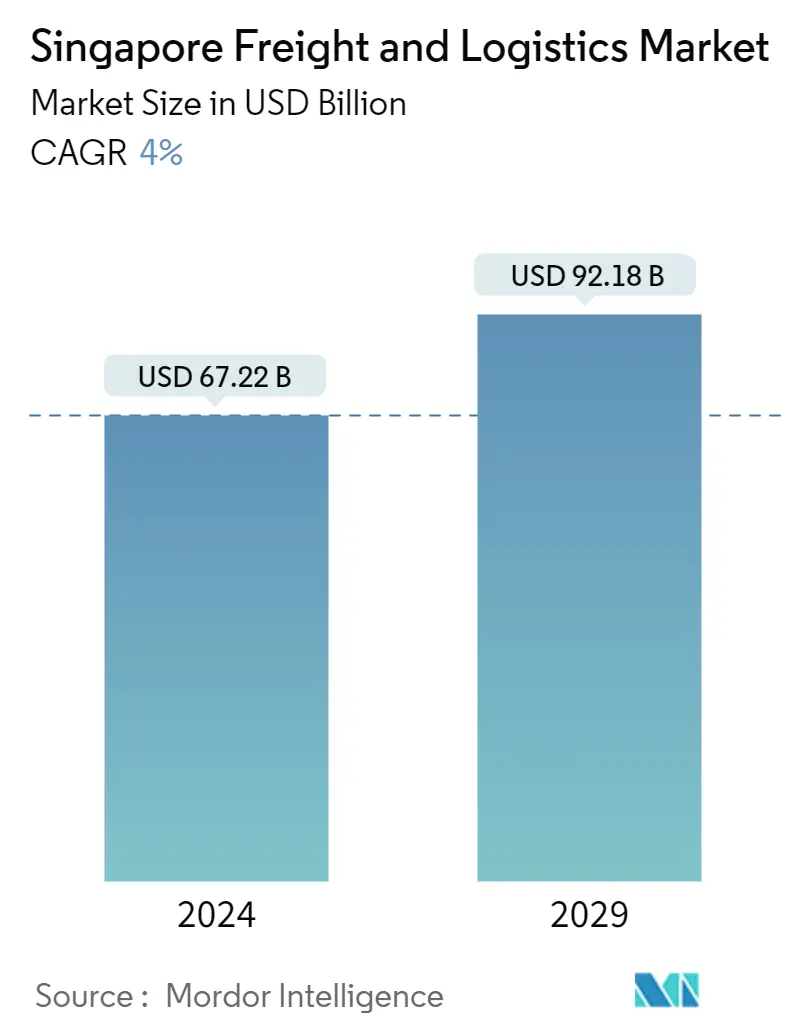
| Study Period | 2020 - 2029 |
| Base Year For Estimation | 2023 |
| Market Size (2024) | USD 67.22 Billion |
| Market Size (2029) | USD 92.18 Billion |
| CAGR (2024 - 2029) | 4.00 % |
| Market Concentration | Low |
Major Players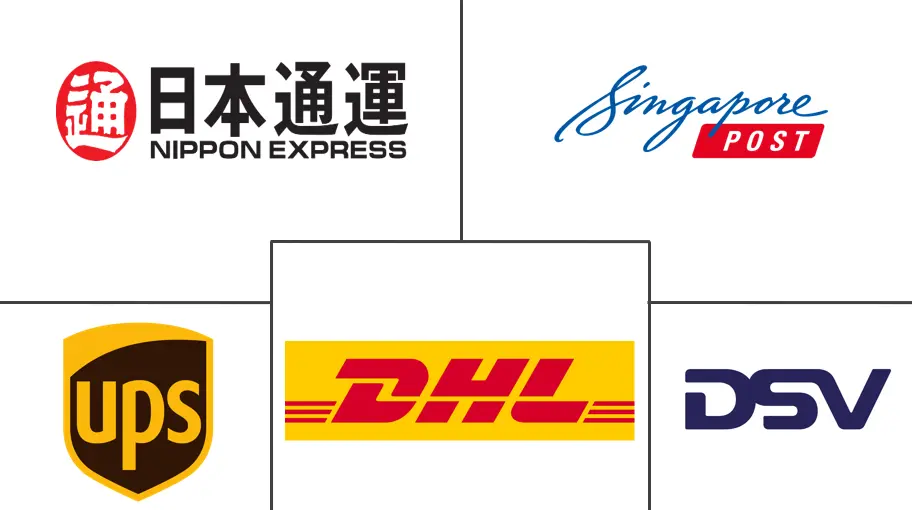
*Disclaimer: Major Players sorted in no particular order |
Singapore Logistics Market Analysis
The Singapore Freight And Logistics Market size is estimated at USD 67.22 billion in 2024, and is expected to reach USD 92.18 billion by 2029, growing at a CAGR of 4% during the forecast period (2024-2029).
During the COVID-19 pandemic, the Maritime and Port Authority of Singapore (MPA) ensured minimum disruption to the shipping industry, as it is critical to supporting Singapore in overcoming the pandemic. The Port of Singapore remains open for cargo operations and marine services, including bunkering, ship supplies, and shipyard repairs, to ensure commerce by sea and global supply chains remain undisrupted.
- Singapore has strengthened its status as a global logistics hub amid the COVID-19 pandemic, riding on its competitive advantages such as the efficiency, reliability, and resilience of its network.
- As Singapore is a major transhipment hub and serves as a gateway to some of the key regions, any changes in the global shipping industry affect Singapore's logistics market, majorly in sea and air. Singapore is also significantly affected by the changes in the global manufacturing sector.
- Government agencies have worked to ensure that any disruptions in Singapore's supply chain network are quickly overcome by providing options in other parts of the network. Singapore has moved toward higher value-added logistics services such as contract logistics that provide customized and end-to-end solutions for companies.
- Leading international logistics firms, such as DHL, UPS, and DB Schenker, have made Singapore their regional headquarters, while multinational corporations, like GlaxoSmithKline and Unilever, have located their regional supply chain management teams.
Singapore Logistics Market Trends
Growing E-commerce in Singapore
Singapore continues to evolve as a major e-commerce market and is expected to grow at a compound annual growth rate of 16.2% from SGD 7.8bn (USD 5.9bn) in 2021 to SGD 14.2bn (USD 10.7bn) in 2025
The first initiative will strengthen Singapore's digital infrastructure, particularly digital connectivity, data analytics, payment systems, and new business innovation.
A key initiative will be developing 5G infrastructure, the backbone of the country's digital economy. About 50% of the country will have 5G coverage within two years, and there will be two nationwide 5G networks by 2025. The greater bandwidth from the networks will increase the capacity to handle large e-commerce orders.
Singapore is ramping up its cybersecurity capabilities to protect businesses and ensure that cross-border data flow is secure.
The country signed the world's first digital-only trade agreement through the Digital Economy partnership Agreement (DEPA) with New Zealand and Chile to strengthen this aspect. Through this agreement, Singapore aims to develop international frameworks to support businesses engaging in cross-border digital trade and e-commerce.
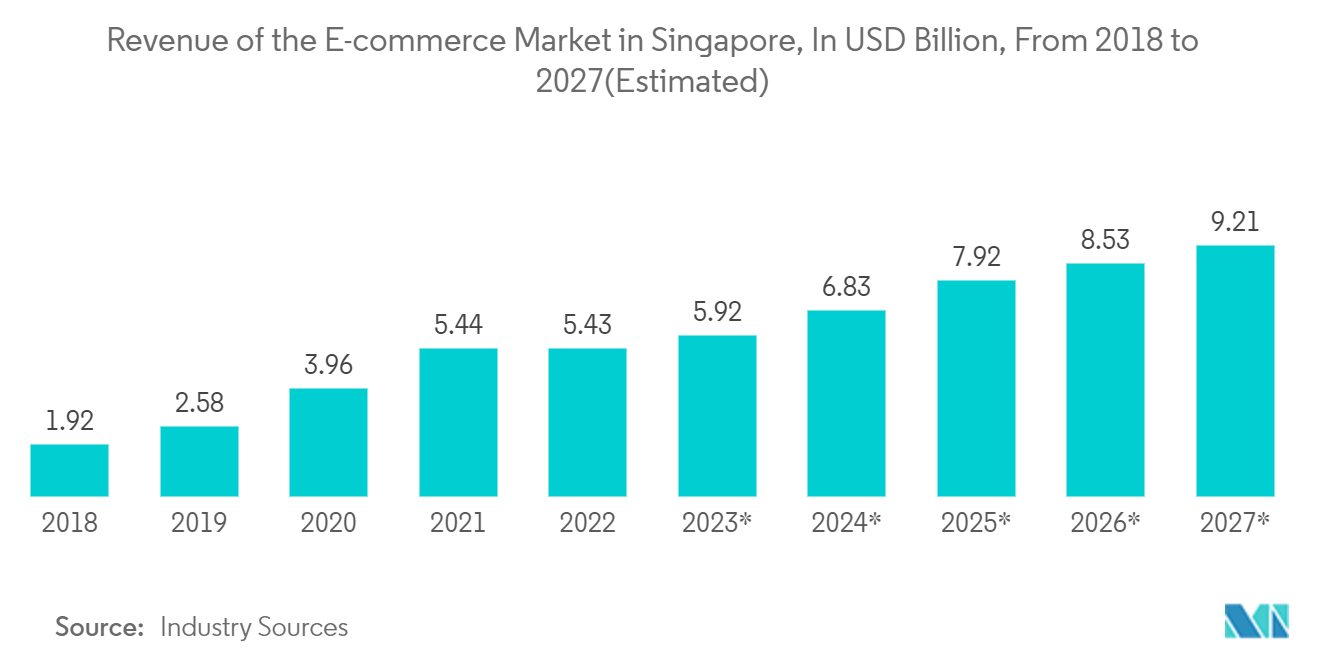
Development of Logistics Infrastructure and Connectivity
The government of Singapore continues to invest in transport infrastructure to maintain the country's position as a world-class city and key transport mode between Asia and the world.
Singapore identified key underlying infrastructures that it believes will pave the way for the country to become a global and regional e-commerce hub. Its "five-pronged" strategy includes building out the local 5G networks, supply chain capabilities, and payment platforms.
Singapore has seamless transport connectivity. It has dense sea and road networks for multimodal transshipment, with a Seamless intermodal connectivity between one of the world's busiest seaports and airports. PSA has four container terminals, one multi-purpose terminal, and one vehicle transshipment terminal operational in the country. PSA also has a huge shipping line network of 200 shipping lines, connecting 123 countries with vessels, with a frequency of 60 per day.
Singapore will also continue to develop its supply chain capabilities. In this regard, Enterprise Singapore and other government agencies will work with the logistics sector to value-add to cold-chain management, retail, and pharmaceutical logistics. A data infrastructure foundation will be built up for sharing secure data across supply chains.
The Singapore government has already started transforming logistics as part of its USD 4.5 billion Industry Transformation Programme. The program's primary objective is to drive excellence in logistics operations and become leaders in innovation while also building a strong core of local logistics talent, making Singapore attractive to inward investment. This scheme is named the Logistics Industry Transformation Map (ITM), and it follows similar plans for Singapore's food and beverage and precision engineering sectors.
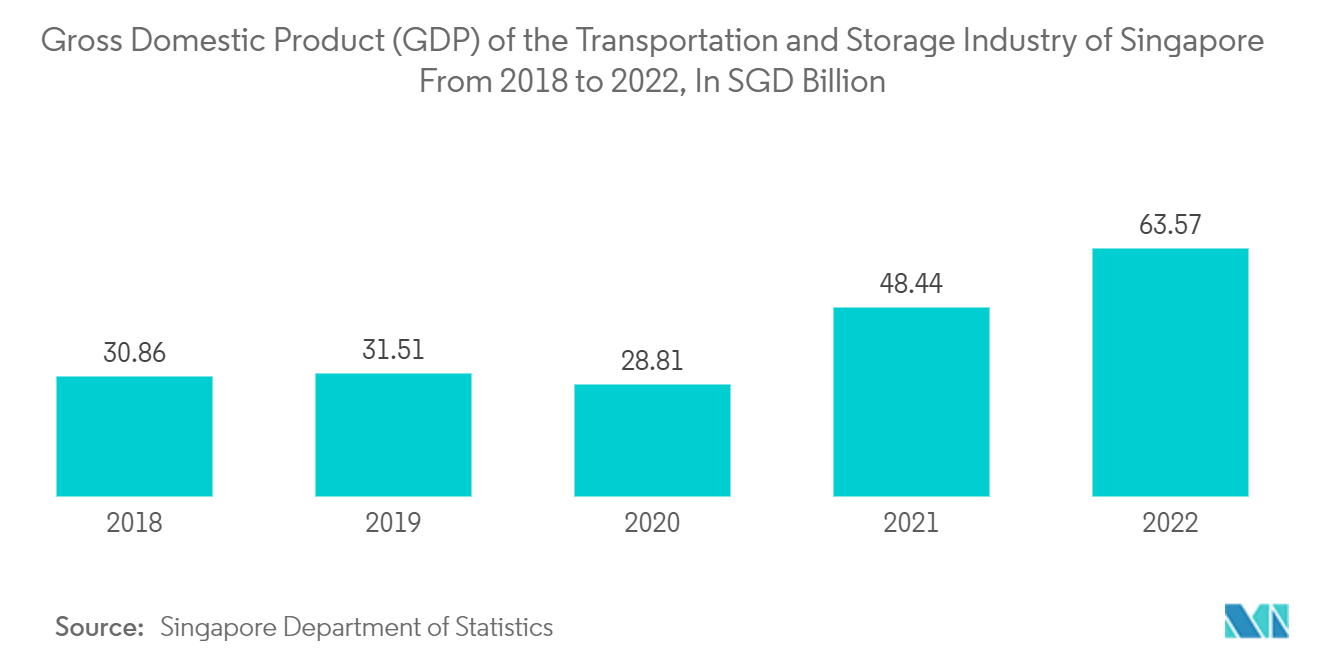
Singapore Logistics Industry Overview
The market is fragmented in nature. Most manufacturing companies base their supply chain control towers and distribution centers in Singapore to orchestrate their regional and global supply chains. This scenario has attracted global logistics companies to mark their footprint in the Singaporean logistics industry. Changi Airport is home to four major express players, DHL Express, FedEx Express, TNT Express, and UPS.
Airport Logistics Park of Singapore (ALPS) has the leading global third-party logistics companies (3PLs), like Expeditors, DB Schenker, and Nippon Express, with sizeable facilities.
Singapore Logistics Market Leaders
-
United Parcel Service
-
Deutsche Post DHL Group
-
Nippon Express Co. Ltd
-
Kerry Logistics Network Limited
-
YCH Group Pte Ltd
*Disclaimer: Major Players sorted in no particular order
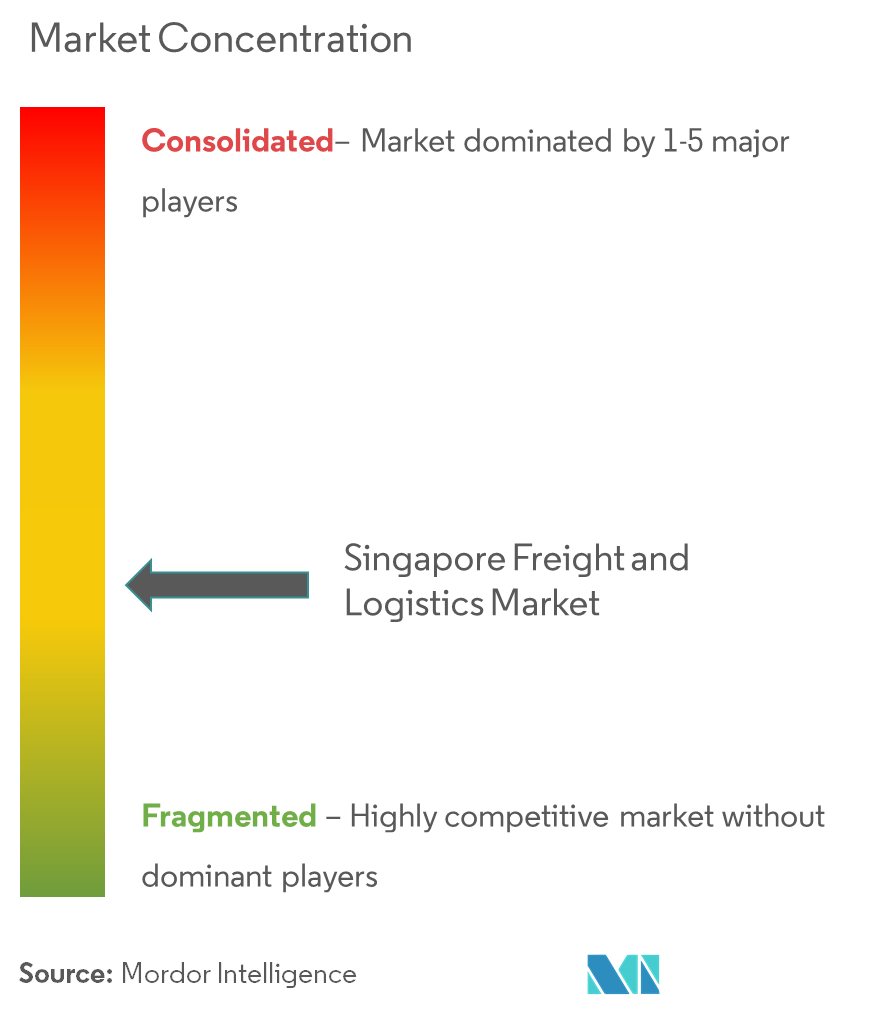
Singapore Logistics Market News
- May 2023: Nippon Express has announced its acquisition of Austrian full-range logistics provider, cargo-partner, making it a subsidiary of the Japanese global logistics services company. The deal was signed on May 12, 2023, and will come into effect subject to the usual regulatory (anti-trust and FDI) approvals in an estimated four to seven months along with the subsequent closing.
- April 2023: DHL Express has partnered Pick Network, a nationwide parcel locker network by the Infocomm Media Development Authority of Singapore, to tap into its full locker network in Singapore. This will enable DHL customers to collect their parcels from another 1,008 lockers near their homes, on top of the existing four DHL Express service centers and over 450 service points across the island.
Singapore Logistics Market Report - Table of Contents
1. INTRODUCTION
- 1.1 Study Assumptions and Market Definition
- 1.2 Scope of the Study
2. RESEARCH METHODOLOGY
3. EXECUTIVE SUMMARY
4. MARKET DYNAMICS AND INSIGHTS
- 4.1 Current Market Scenario
-
4.2 Market Drivers
- 4.2.1 Growing global trade activities
- 4.2.2 Infrastructure Development is on rise
-
4.3 Market Restraints
- 4.3.1 Manufacturers' lack of control over logistics services and also increasing logistical costs
-
4.4 Market Opportunities
- 4.4.1 Importing and exporting commodities along with the growth in transportation and trade globally
- 4.5 Value Chain / Supply Chain Analysis
-
4.6 Porter's Five Forces Analysis
- 4.6.1 Threat of New Entrants
- 4.6.2 Bargaining Power of Buyers/Consumers
- 4.6.3 Bargaining Power of Suppliers
- 4.6.4 Threat of Substitute Products
- 4.6.5 Intensity of Competitive Rivalry
- 4.7 Government Regulations and Initiatives
- 4.8 Technological Trends and Automation
- 4.9 Brief on Freight Rates
- 4.10 Insights on Bunkering Services
- 4.11 Review and Commentary on Singapore's Relation with Other ASEAN Countries (Analyst's View)
- 4.12 Spotlight- Role of Singapore as a Transshipment Hub
- 4.13 Impact of COVID-19 on the Market
5. MARKET SEGMENTATION (Market Size By Value)
-
5.1 By Function
- 5.1.1 Freight Transport
- 5.1.1.1 Road
- 5.1.1.2 Sea
- 5.1.1.3 Air
- 5.1.1.4 Rail
- 5.1.2 Freight Forwarding
- 5.1.3 Warehousing and Storage
- 5.1.4 Value-added Services and Others
-
5.2 By End User
- 5.2.1 Manufacturing and Automotive
- 5.2.2 Oil and Gas, Mining, and Quarrying
- 5.2.3 Agriculture, Fishing, and Forestry
- 5.2.4 Construction
- 5.2.5 Distributive Trade (Wholesale and Retail)
- 5.2.6 Healthcare and Pharmaceutical
- 5.2.7 Other End Users
6. COMPETITIVE LANDSCAPE
- 6.1 Overview (Market Concentration and Major Players)
-
6.2 Company Profiles
- 6.2.1 United Parcel Service
- 6.2.2 Deutsche Post DHL Group
- 6.2.3 Singapore Post Limited
- 6.2.4 ACW Logistics Pte Ltd
- 6.2.5 Keppel Logistics Pte Ltd
- 6.2.6 CWT Pte Ltd
- 6.2.7 YCH Group Pte Ltd
- 6.2.8 Yamato Transport
- 6.2.9 Deutsche Post DHL Group
- 6.2.10 DSV
- 6.2.11 Kuehne + Nagel International AG
- 6.2.12 Nippon Express Co. Ltd
- 6.2.13 Expeditors International
- 6.2.14 Yusen Logistics Co. Ltd
- 6.2.15 FedEx Corporation
- 6.2.16 Deutsche Bahn AG
- 6.2.17 Agility Logistics
- 6.2.18 CEVA Logistics*
- *List Not Exhaustive
7. FUTURE OF THE MARKET
8. APPENDIX
- 8.1 GDP Distribution, by Activity
- 8.2 Insights on Capital Flows
- 8.3 Economic Statistics - Transport and Storage Sector and Contribution to Economy
- 8.4 External Trade Statistics - Export and Import, by Product
- 8.5 Insights on Key Export Destinations
- 8.6 Insights on Key Import Origin Countries
Singapore Logistics Industry Segmentation
Freight refers to goods, items, or commodities transported in bulk via air transport, surface transport, or sea/ocean transport. Logistics refers to managing how resources are acquired, stored, and transported to their final destination.
A comprehensive background analysis of the Singapore Freight And Logistics Market, covering the current market trends, restraints, technological updates, and detailed information on various segments and the competitive landscape of the industry. The impact of COVID-19 has also been incorporated and considered during the study.
The Singapore Freight and Logistics Market is segmented By Function (Freight Transport, Freight Forwarding, Warehousing and Storage, and Value-added Services and Other Services) and End-User (Manufacturing and Automotive, Oil and Gas, Mining, and Quarrying, Agriculture, Fishing, and Forestry, Construction, Distributive Trade, Healthcare and Pharmaceutical, and Other End Users). The report offers market size and forecasts for the Singapore Freight and Logistics Market in value (USD) for the above-mentioned segments.
| By Function | Freight Transport | Road |
| Sea | ||
| Air | ||
| Rail | ||
| By Function | Freight Forwarding | |
| Warehousing and Storage | ||
| Value-added Services and Others | ||
| By End User | Manufacturing and Automotive | |
| Oil and Gas, Mining, and Quarrying | ||
| Agriculture, Fishing, and Forestry | ||
| Construction | ||
| Distributive Trade (Wholesale and Retail) | ||
| Healthcare and Pharmaceutical | ||
| Other End Users |
Singapore Logistics Market Research FAQs
How big is the Singapore Freight and Logistics Market?
The Singapore Freight and Logistics Market size is expected to reach USD 67.22 billion in 2024 and grow at a CAGR of 4% to reach USD 92.18 billion by 2029.
What is the current Singapore Freight and Logistics Market size?
In 2024, the Singapore Freight and Logistics Market size is expected to reach USD 67.22 billion.
Who are the key players in Singapore Freight and Logistics Market?
United Parcel Service, Deutsche Post DHL Group, Nippon Express Co. Ltd, Kerry Logistics Network Limited and YCH Group Pte Ltd are the major companies operating in the Singapore Freight and Logistics Market.
What years does this Singapore Freight and Logistics Market cover, and what was the market size in 2023?
In 2023, the Singapore Freight and Logistics Market size was estimated at USD 64.53 billion. The report covers the Singapore Freight and Logistics Market historical market size for years: 2020, 2021, 2022 and 2023. The report also forecasts the Singapore Freight and Logistics Market size for years: 2024, 2025, 2026, 2027, 2028 and 2029.
What are the key segments of the Singapore Freight and Logistics Market?
The key segments of the Singapore Freight and Logistics Market are a) Transportation Mode: Air Freight, Sea Freight, Road Freight, Rail Freight b) Logistics Services: Freight Forwarding, Warehousing and Storage, Third-Party Logistics (3PL) Services c) Industry Vertical: E-commerce and Retail, Manufacturing d) Technology Integration: Digital and Tech-Driven Logistics and Traditional Logistics
Singapore Freight and Logistics Industry Report
The Singapore Freight and Logistics Market is experiencing significant growth, driven by advancements in digital and tech-driven logistics that enhance efficiency and provide real-time tracking capabilities. This market is segmented by various transportation modes, with road freight being notably extensive and sea freight rapidly expanding. Prominent logistics services such as third-party logistics (3PL) and freight forwarding cater to a diverse range of sectors including e-commerce, retail, and manufacturing. Specialized services like project cargo handling and exhibition and event logistics play crucial roles, underscoring the market's versatility. Temperature-controlled logistics, particularly refrigerated logistics, are essential for managing perishable goods. Additionally, the market emphasizes customs brokerage and regulatory compliance to facilitate smooth international trade.
The report offers an industry overview and a comprehensive market outlook, detailing the market size and market segmentation. The market forecast highlights the industry growth and market growth, with an emphasis on market predictions and market trends. The industry profile includes industry statistics, industry analysis, and industry information, providing a thorough market review and market data. The market report is available as a report pdf, offering an in-depth look at the market value and industry size.
The industry reports and industry research provide insights into industry sales and the growth rate of the market. The report example includes data on market leaders and research companies, offering valuable market insights. The market overview and market outlook are essential for understanding the market dynamics and future market predictions. Access the free report pdf download for a detailed analysis of the Singapore Freight and Logistics market.



